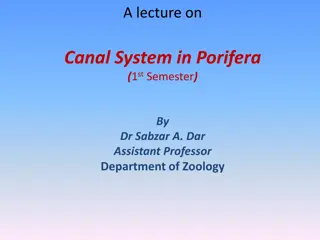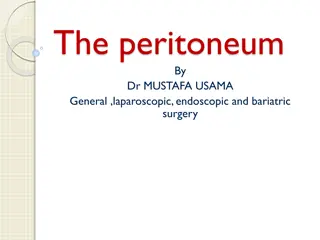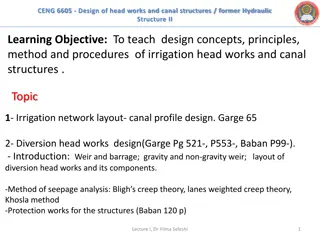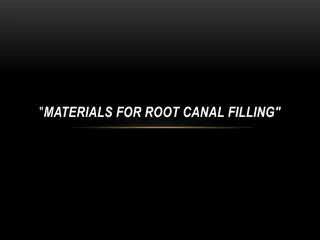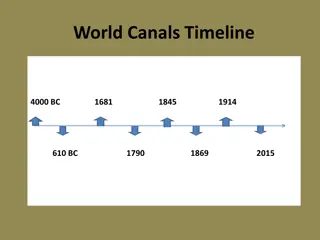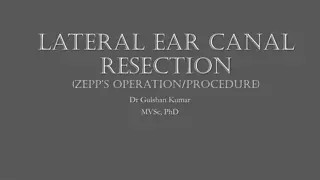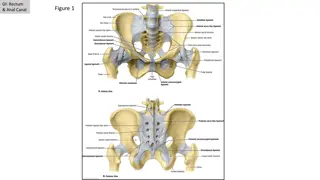Understanding Peritoneum and Inguinal Canal in Anatomy
Peritoneum is a thin serous membrane covering the abdomen and pelvis, consisting of parietal and visceral layers with a peritoneal cavity between them. Learn about peritoneal relations, intraperitoneal versus retroperitoneal organs, and folds of peritoneum like ligaments and omenta in this detailed anatomy study.
Download Presentation

Please find below an Image/Link to download the presentation.
The content on the website is provided AS IS for your information and personal use only. It may not be sold, licensed, or shared on other websites without obtaining consent from the author. Download presentation by click this link. If you encounter any issues during the download, it is possible that the publisher has removed the file from their server.
E N D
Presentation Transcript
Peritoneum and Inguinal canal Department of anatomy and histology Anatomy lab Second stage Presented by Msc. Dr. Reham saad Kadhum
Peritoneum Its thin serous membrane that lines the wall of abdomen and pelvis and clothes the viscera . Consist of 2 layers ( parietal which covers the abdominal cavity , visceral which lines the viscera ) Between the parietal and visceral peritoneum there's a peritoneal cavity witch is the largest cavity in the body and divided into 2 sac greater sac and lesser sac , and this cavity is closed in male while its not in female because its communicates with utrain tube , uterus and vagina . Greater sac extends from diaphragm to pelvis , while the lesser lies behind the stomach and lesser omentum, It extends upward as far as the diaphragm and downward between the layers of the greater omentum . The greater and lesser sac are in free communication through the an oval window called open to lesser sac or ( the epiploic foramen ) which present in right margin to the lesser sac cavity called
Intraperitoneal and Retroperitoneal Relations The terms intraperitoneal and retroperitoneal are used to describe the relationship of various organs to their peritoneal covering . Intraperitoneal organs : Organs is said to be intraperitoneal when it is almost totally covered with visceral peritoneum. , like (stomach, jejunum, ileum, and spleen are good examples of intraperitoneal organs ) Retroperitoneal organs lie behind the peritoneum and are only partially covered with visceral peritoneum. Like (pancreas and the ascending and descending parts of the colon are examples of retroperitoneal organs)
Folds of Peritoneum They are double layers of peritoneum connecting abdominal wall or organs to each other or to the abdominal wall . The peritoneal ligaments, omenta, and mesenteries permit blood, lymph vessels, and nerves to reach the viscera. They are name according to each organs : 1. Peritoneal Ligaments Peritoneal ligaments are two-layered folds of peritoneum that connect solid viscera to the abdominal walls. The liver, for example, is connected to the diaphragm by the falciform ligament, the coronary ligament, and the right and left triangular ligaments
2. Omenta : are two-layered folds of peritoneum that connect the stomach to another viscus. The greater omentum connects the greater curvature of the stomach to the transverse colon . It hangs down like an apron in front of the coils of the small intestine and is folded back on itself to be attached to the transverse colon . The lesser omentum suspends the lesser curvature of the stomach from the fissure of the ligamentum venosum and the porta hepatis on the undersurface of the liver The gastrosplenicomentum (ligament) connects the stomach to the hilum of the spleen .
3. Mesenteries Mesenteries are two-layered folds of peritoneum connecting parts of the intestines to the posterior abdominal wall, For example, the mesentery of the small intestine. 4. Meso colon found in large intestine ( transverse mesocolon , sigmoid mesocolon )
Peritoneal Pouches, Recesses, Spaces, and Gutters : 1. Duodenal Recesses Close to the duodenojejunal junction, there may be four small pocketlike pouches of peritoneum called the superior duodenal, inferior duodenal, paraduodenal, and retroduodenal recesses , fig ( 5-12)
2. Cecal Recesses Folds of peritoneum close to the cecum produce three peritoneal recesses called the superior ileocecal, the inferior ileocecal, and the retrocecal recesses . 3. Intersigmoid Recess is situated at the apex of the inverted, V-shaped root of the sigmoid mesocolon Its mouth opens downward.
4.Sub phrenic Spaces The right and left anterior subphrenic spaces lie between the diaphragm and the liver, on each side of the falciform ligament . The right posterior subphrenic space lies between the right lobe of the liver, the right kidney, and the right colic flexure The right extraperitoneal space lies between the layers of the coronary ligament and is therefore situated between the liver and the diaphragm . 5. The Paracolic Gutters lie on the lateral and medial sides of the ascending and descending colons, respectively . The subphrenic spaces and the paracolic gutters are clinically important because they may be sites for the collection and movement of infected peritoneal fluid .
Nerve Supply of the Peritoneum The parietal peritoneum is sensitive to pain, temperature, touch, and pressure ( p 2 t 2 ) . \ anterior abdominal wall : lower 6 thoracic nerves and L1 n. \ dighragm : cental ( phrenic n. ) peripheral ( lower 6 thoracic . Nerves ) \ pelvis : obturator n. The visceral peritoneum is sensitive only to stretch and tearing and is not sensitive to touch, pressure, or temperature. supplied by autonomic afferent nerves.
Inguinal canal The inguinal canal is an oblique passage through the lower part of the anterior abdominal wall. In the males, it allows structures to pass to and from the testis to the abdomen. In females, it allows the round ligament of the uterus to pass from the uterus to the labium magus. The canal is about 1.5 in. (4 cm) long in the adult and extends from the deep inguinal ring, a hole in the fascia transversalis downward and medially to the superficial inguinal ring, a hole in the aponeurosis of the external oblique muscle . It lies parallel to and immediately above the inguinal ligament.
The deep inguinal ring, * an oval opening in the fascia transversalis, lies about 0.5 in. (1.3 cm) above the inguinal ligament midway between the anterior superior iliac spine and the symphysis pubis Related to it medially are the inferior epigastric vessels, which pass upward from the external iliac vessels. The margins of the ring give attachment to the internal spermatic fascia (or the internal covering of the round ligament of the uterus). The superficial inguinal ring* is a triangular-shaped Defect in the aponeurosis of the external oblique muscle and lies immediately above and medial to the pubic tubercle , The margins of the ring, sometimes called the crura, give attachment to the external spermatic fascia.
Walls of the Inguinal Canal Anterior wall. External oblique aponeurosis, reinforced laterally by the origin of the internal oblique from the inguinal ligament .. Posterior wall. Conjoint tendon medially, fascia transversalis laterally Roof or superior wall. Arching lowest fibers of the internal oblique and transversus abdominis muscles Floor or inferior wall. Upturned lower edge of the inguinal ligament and, at its medial end, the lacunar ligament .






